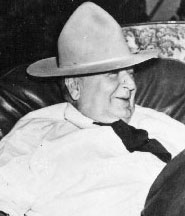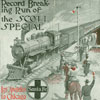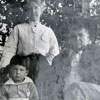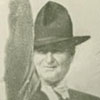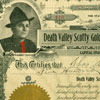|
Cassey Jones, Death Valley National Park, Interpretive Park Ranger
Diana Valdez-Bartlett, Teacher, Cottonwood Elementary Palmdale, CA
- 5-8
2 lessons in unit
Lesson 1: 60 min
Lesson 2: part 1 – 60 min, part 2 – 60 min
[Back to top]
|
- Death Valley National Park
- Death Valley Scotty embodied the myth of the “Wild West”, due to his various exploits and his eccentric character. In this unit, students to analyze key objects derived from the life of the famous Death Valley Scotty. The lessons are designed to help students draw connections between museum objects and the legacy of Scotty’s tall tales. Lessons focus on developing language arts skills such as reading for understanding, drawing inferences, oral fluency, and communication skills. Students also learn about an eccentric character in regional history. After investigating the life and character of Death Valley Scotty, students will construct their own tall tale in the form of a play.
- Who was Death Valley Scotty, and how did the tall tales play a role in shaping his legend or persona?
[Back to top]
|
| MUSEUM OBJECT [photos of objects in the Carl Sandburg Home NHS museum collections] |
SIMILAR OBJECTS [local items similar to museum objects] & OTHER MATERIALS |
Length of time |
|
|
60 minutes
|
Lesson Two: A tall tale inspired by The Mysterious Scott: The Monte Cristo Of Death Valley |
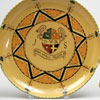 |
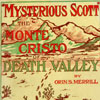 |
Dinnerware
|
"Mysterious Scott" The Monte Cristo of Death Valley |
|
- A contemporary ceramic plate, without the edge curled.
- A copy of a fictional book or play with an interesting title, such as Haruki Murakami’s Hard-Boiled Wonderland and the End of the World
- Photo of shot splitter from Scotty's back porch. “
- Tall tales number 1 and 2 located in section I under lesson implementation procedures.
|
Part 1 –
30 minutes
Part 2 –
60 – 120 minutes
|
[Back to top]
|
NL-Eng.K-12.2 Reading for Understanding
NL-Eng.K-12.3 Evaluation Strategies
NL-Eng.K-12.4 Communication Skills
NA-T.K-4.1 and NA-T.5-8.1 Script Writing by planning and recording improvisations based on personal experience and heritage, imagination, literature, and history.
NA-T.K-4.2 and NA-T.5-8.2 Acting by Assuming Roles and Interacting in Improvisations
NA-T.K-4.3 and NA-T.5-8.3 Designing by Visualizing and Arranging Environments for Classroom Dramatizations
NA-T.K-4.4 and NA-T.5-8.4 Directing by Planning Classroom Dramatizations
[Back to top]
|
After this lesson, students will be able to:
- Evaluate historical information, documents, and photographs from the museum collection to draw inferences about Death Valley Scotty’s character.
- Revise character analysis based on the synthesis of new data.
- Compose a script based on the life and exploits of Death Valley Scotty.
- Construct key elements of a play, such as: stage direction, tone of voice, setting, plot, conflict/resolution, dialogue, and character development.
- Apply oral, written, performance communication skills via dramatization.
[Back to top] |
Scotty’s Castle, in the northern part of Death Valley National Park, is a popular site for visitors, who enjoy stepping back in time to the 1930s for a living history tour of the building. Some say Death Valley Scotty built the Castle with money from his secret gold mine. Others say Chicago millionaire Albert Johnson built it. Regardless of who was responsible, the Castle is a testament to the ingenuity and character of the people involved. The friendship that developed between the two very different men and included Albert's wife Bessie is also part of the story. So ... whose castle was it?
Regardless of the source of his income, Death Valley Scotty certainly remains one of Death Valley's greatest legends for his flamboyant and outrageous character. Born Walter Scott in 1872, he ran away as a young boy from his home in Kentucky to join his brother on a ranch in the Nevada desert. He worked numerous jobs in the area, including a few in Death Valley, a place he loved immediately and which would someday become his home. In 1890 a talent scout for Bill Cody discovered Scotty and hired him to work as a cowboy with Buffalo Bill's Wild West Show.
After traveling the world with the Wild West show for twelve years, Scotty began a new profession that brought him even more fame and riches - gold prospecting. He convinced several wealthy businessmen that he had a claim to a fabulous gold mine in Death Valley. Scotty agreed to split the all profits, provided they first offer money to extract the ore. Over the next few years, Scotty apparently had little luck prospecting in Death Valley. After receiving no results from the fabled gold mine, all of his investors felt that they had been conned and began to back out of their investments. Scotty, however, started turning up at the finest hotels and saloons of California and Nevada, and began what would become his legendary spending sprees.
Scotty's remaining investor was Chicago insurance magnate Albert Mussey Johnson. The two men struck quite a contrast to one another when they met soon after the turn of the century. Mr. Johnson was a well respected and religious man, whereas Scotty was a rowdy and shady character. Convinced to invest in Scotty's mine, Mr. Johnson gave thousands of dollars to Scotty over the next several years. Unfortunately, at least according to Scotty, a number of calamities prevented delivery of the gold. Undaunted, Mr. Johnson finally decided to take a look at the gold mine on a personal tour of Death Valley.
Scotty remained cool. Using his Grapevine Canyon home as base camp, Scotty took Mr. Johnson on a grueling trek by horseback through Death Valley. He figured a few days in the desert would be too much for the city slicker whose health had been permanently by a near-fatal train accident in his youth. Surprisingly, Johnson loved Death Valley so much that he stayed nearly a month, and his health improved dramatically in the dry, sunny climate.
Although he never saw Scotty's mine and was most certainly being swindled, Mr. Johnson did not seem to mind. He had found riches in the desert far greater than those that glitter. Besides, he had taken a liking to the eccentric desert rat. The two men began a lifelong friendship that would change the history of Death Valley forever. Over the next ten winters, Albert Johnson often returned to Death Valley. His wife, Bessie Penniman Johnson, began to accompany him and Scotty on their desert expeditions. Mrs. Johnson suggested that they build something more comfortable for their vacations, so as to "get away from the rattlesnakes and scorpions." This idea led to the construction of the Death Valley Ranch in the 1920's.
Recognizing a good story, Scotty told everyone that he was building the two million dollar home with profits from his gold mine. When questioned by the droves of reporters who visited, Mr. Johnson agreed that Scotty owned the place, and simply said that he was "Scotty's banker." Construction was halted in 1931 when Mr. Johnson discovered that due to a surveying error, he was building his castle on federal land. The Great Depression was beginning to take hold and construction on the Castle was never restarted. Today the Castle remains as Albert left it - incomplete.
[Back to top] |
Stock Certificate: A certificate establishing ownership of a stated portion (number of shares) of a corporation.
Mining: The process of extracting minerals from a mine.
Death Valley: A desert basin, 1,500 square miles in area, in eastern California and Western Nevada, containing the lowest point in the Western Hemisphere (282 feet below sea level).
Buffalo Bill: (legal name, William Fredrick Cody) 1846-1917, an American frontiersman, scout, and showman.
Castle: a place of privacy, security, or refuge, often quite architecturally elaborate.
Antique: An object having special value because of its age; especially a work of art or handicraft that is at least 50 years old.
Structure: Something constructed, especially a building.
Tapestry: A heavy fabric with colorful woven designs, used for wall hanging, furniture covering, etc.
Wild West: The western United States during the period of its settlement, especially in reference to its lawlessness.
Prospector: A person who explores an area for natural, economically valuable deposits, such as gold or oil.
Calamity: A disaster.
City slicker: A person exhibiting the smart and sophisticated style traditionally associated by rural people with the manners of the city.
Swindle: To cheat someone out of money or property.
Eccentric: Departing from a normal course; especially, a person with an unusual personality.
Scorpion: An arachnid living in warm, dry regions, having a segmented body and a tail tipped with venomous stinger.
Construction: To form by assembling parts; to build.
Survey: To determine the boundaries, the area, or the elevations of something or someplace by means of measuring angles and distances.
(Great) Depression: A period of drastic decline in the United States economy (beginning in 1929, and lasting through most of the 1930s), characterized by decreasing business activity, falling prices, and unemployment.
Preserve: To keep in perfect or unaltered condition; maintain in an unchanged form.
Scene: A section of a play that usually includes one setting.
Director: A person who supervises and instructs the actors in a dramatic production.
Tall tale: A story that includes exaggeration about someone or some event.
Bandit: A robber or thief
Monte Cristo: A reference to The Count of Monte Cristo, a fiction novel by Alexander Dumas (who also wrote The Three Musketeers), in which a sailor discovers a fabulous treasure on the Italian island of Monte Cristo, and reinvents himself as a wealthy aristocrat.
[Back to top]
|
|
- Download and laminate color prints of the museum objects used in the lesson unit plan.
- Use Post-It style poster paper, so that the students’ bubble charts will stick easily to the walls around the classroom.
- For the first activity, find a photograph that the students can draw interesting inferences about, for example, a man in Bermuda shorts wearing a Darth Vader mask or a woman standing outdoors in a meadow. You can use the image of “Shorty” Harris and his mule from the Death Valley National Park website if you do not have your own photo.
- Download and laminate color prints of the museum objects used in the lesson unit plan
[Back to top] |
1) Project the interesting photograph of a person onto a screen at the front of the classroom. Provide students with 1-2 facts about the person. These facts may be true (if the photograph is historic) or made up by the teacher.
2) As a whole class, ask the students to describe who the person is or what he/she is like, based on examination of the photograph, and the facts presented by the teacher. Draw a bubble map on the board to capture these inferences (see template in section N). In the center circle of the map, write who the students believe is in the photograph. Next, draw connecting circles radiating from center circle. These circles will contain descriptions the students formulate about the person, based on details they see in the photograph. For example, if the person is a female standing outside in a meadow, the students may infer the person loves the outdoors and is hiking.
3) Emphasize that for people the students haven’t met, photographs and other images or documents may be the only way to “get to know” them. State that the class is going to do an exercise to “get to know” a historical figure named Walter Scott, aka Death Valley Scotty, using objects from a museum collection that were once part of Scotty’s life.
4) Explain to students that in small groups they will be given four photographs with a few facts attached to each. Provide them with large sheets of butcher paper and markers for each group to construct their own bubble map about Death Valley Scotty. Give each group a set of four historic photos and documents, with the facts below printed on the back of the object images.
Object 1: Historic photo of record breaking run of the Scott Special, DEVA 21458A
Facts: Walter Scott did break a land speed record in 1905 for completing a train trip from Los Angeles to Chicago in 44 hours and 55 minutes. One of the people waiting at the Chicago finish line was Albert Johnson who later became a close friend of Scotty’s.
Possible inferences: Scotty must love being the center of attention to have an entire train race named after him. Next student- He must be rich to own his own train!
Object 2: Historic photo of Scotty with wife and child, DEVA 15944 PG49 O
Facts: Scotty had a wife named Ella Josephine Milius and a son named Walter Jr.
Possible inferences: Scotty must have loved his family if he sat down to take a picture with them. Next student- I don’t know, that’s an interesting idea but no one is smiling in the picture so I don’t think they are very close.
Object 3: Historic photo of Walter Scott on horse, DEVA40952
Facts: Walter Scott was in ‘Buffalo Bill’s Wild West Show’ when he was young. This is an authentic photograph of a horse from the Wild West.
Possible inferences: Walter Scott must be brave and strong to get on a horse that could throw him off! Next student- Wait a minute, the teacher said the horse was real, but Scott was young when he was in the show. This guy head looks like it was glued on the body. I don’t think this is real.
Object 4: Copy of stock share for gold mine, DEVA24129A
Facts: This is an authentic stock certificate for the state of Arizona. Death Valley Scotty never owned a gold mine.
Possible inferences: How did he get an official document from the government saying he had a gold mine, if he never did? He seems dishonest. Next student- Look at the picture of him on the document, he seems really into himself.
5) Through observation and group discussion, students will draw inferences based on the details in the photographs and accompanying facts. The facts are unbiased so students can formulate their own perceptions. Encourage students to interact respectfully and listen fairly to each others’ ideas.
6) Each group presents its bubble map in front of the whole class. The teacher leads a brief discussion on the similarities and differences between the groups’ assessments of Death Valley Scotty’s character. Point out that given the same limited evidence, historians or museum curators may come to different conclusions about a historical figure, just like each student group did.
7) Hand out a copy Death Valley Scotty’s biography to each student (see section C for the website where you can download the biography). Based on your class dynamic, decide how to have the students read this material. You could have the class read the biography chorally (see note below), have individual students each read one paragraph aloud, have the students read aloud in table groups, or have each student read silently to him/herself. (Choral reading- All students, and the teacher, read aloud and together at the same time. This is a strategy to promote better oral fluency among all students. Also, no student is singled out to read alone and experience anxiety or embarrassment.)
8) Discuss with students some of the key features of Scotty’s life. Encourage students to think about any new aspects of Scotty’s character they did not already identify. Students will discuss and reflect on the new information in their groups, revising their bubble maps and adding new details as necessary.
9) Students present their revised bubble maps to the class.
10) In closing, restate the essential question: “Today we were trying to determine, Who was Death Valley Scotty?” Call on students to state the learning objectives for each part of the lesson, for example: First we analyzed pictures from Scotty’s life to determine his character traits. Second, as a group we created a bubble map to show the traits. Third, we chorally read Scotty’s biography and talked about what he really did in his life. Last we made changes to our bubble map to include the new information. Ask the students what they learned, guiding them toward the idea that you can’t always assume people or events are what they seem. Emphasize that by looking critically at evidence, they can gain a broader understanding of historical people and events.
Part 1:
1) Pose the question, “Have you ever heard a tall tale?” to the class, and seek a few responses. Refer back to some of the tall tales in Lesson 1 pertaining to Death Valley Scotty. Emphasize that a tall tale usually contains an element of exaggeration. While projecting an image of the related museum object onto a screen at the front of the class, read aloud the tall tales written below. After you have finished reading each tale, ask the students if they think it is true. If not, what do they think is false about it? Ask them if they think the exaggeration make the story more or less interesting. This will serve as a prelude to the students creating their own tall tale in the form of a play.
Tall Tale 1: Display the photograph of the curled plate from museum collection, DEVA12644. Ask the students what they think happened to the plate. Pass around a contemporary ceramic plate while sharing the following story:
“This is the story that Scotty told all the time over dinner to castle visitors. Scotty told everyone that he was in the castle one day and he decided to help the maids do the dishes. Scotty thought that the plates would dry faster if he sat them outside. The plates were put outside in the shade, which he claimed was 150 degrees year round. While the plates were drying, Scotty got distracted and the sun shifted, exposing part of the plate to direct sunlight. Scotty said that when he went back outside to check and see if the plates were dry, they had already gotten so hot, they had melted and curled!”
After you finish the story, ask the students if you think this could happen to the plate they have been passing around. If it is really hot where you live, you might even perform an experiment by wetting the plate and leaving it outside to dry, to see if it curls. Use this discussion as a jumping off point for emphasizing the exaggerated nature of tall tales.
Tall Tale 2: Display the photograph of the shot splitter (download from virtual museum lesson plan server). Ask the student if they can guess what this contraption was used for. Next, share the following story:
“Scotty told everyone that he had a gold mine under the castle, more specifically underneath his bed. According to Scotty, bandits were always trying to break into his room and rob him of his gold. Scotty said that the bandits who tried to rob him always traveled in pairs. They needed one guy to knock at the door and make lots of noise in order to distract Scotty, so the other bandit could sneek in the room through the nearby window. As a result, he would need to kill two bandits, standing in two different locations, with one shot, in order to defend his treasure. Impossible? Not according to Scotty. Although it strongly resembled a device used in Buffalo Bill’s Wild West show, Scotty claimed he invented the “shot splitter”. This contraption is a piece of metal that covered a hole through the wall of the castle near the door. The hole was just the right size for the barrel of a gun. All Scotty had to do was shoot the gun in the hole, the bullet would hit the metal, split in two, and hit both the bandit by the door and the bandit by the window. This idea is regarded among experts to be false and unrealistic. Also, since there is no gold mine under Scotty’s bed, it doesn’t really matter whether the shot splitter actually works. But it makes a great story!”
Part 2
2) Tell students that due to Scotty’s tall tales, there was plenty of mystery and sensationalism surrounding his life. This prompted a fictional novel to be written about his escapades. Project an image of the cover of The Mysterious Scott: The Monte Cristo of Death Valley onto a screen at the front of the room.
3) Explain to the class the meaning of the book’s title (see Vocabulary list in section G for the context behind labeling Scotty a “Monte Cristo”). Tell the students that they will write their own tall tale about Walter Scott, in the form of a play, in groups of 4-5 students. The play should have a minimum of two scenes, and must include at least the characters Walter Scott, Albert Johnson, and Bessie Johnson. It should be 5-10 minutes in length, with the level of sophistication based on the abilities of your students. The production can be elaborate, involving costumes and scenery, or very simple, in which students perform in their regular clothes, without any props. Every person in the group must contribute to writing the play, and every person must participate in its production (as an actor, director, or costume & prop manager). The tall tale should use the title of the book The Mysterious Scott: The Monte Cristo of Death Valley, but the play shouldn’t be based on the actual contents of the story, but rather stem from the group’s imagination, based on their understanding of Death Valley Scotty and the Johnsons.
4) Give the students time to write and rehearse the play. This could take place during a single day, or in small chunks of time over multiple days.
5) Students present their group plays to the whole class, or to other classes, or to parents.
Wrap Up Activity and Discussion
Have students consider whether there is anyone in their life that is like Death Valley Scotty – perhaps an eccentric uncle, or grandfather. Ask students what artifacts (photos, diaries, newspaper clippings, etc.) might be left behind from the lives of these friends or relatives that would tell their story to future historians or museum curators. See section K for Extension Activities that elaborate upon this line of inquiry.
[Back to top]
|
Lesson 1: The revised bubble maps produced by the students will be the measurable product for evaluation. See the Character Trait Rubric located under section N.
Lesson 2: The written play and the students’ performance of it will be the measureable product for evaluation. See the Tall Tale Rubric located under section N.
[Back to top]
|
Lesson 1:
1) Show the students a short clip from a DVD of the Death Valley Days television show to provide them with further background knowledge regarding the environment, culture, and time period in which Death Valley Scotty made his mark.
2) Students create a Power Point about the Wild West.
3) Students create an informational pamphlet about Buffalo Bill (see section L for additional resources).
4) Explore Scotty’s Castle online by taking the Virtual House Tour (at http://www.nps.gov/museum/exhibits/deva/house_tour.html ). Have the students focus specifically on Scotty’s room and the objects therein. Discuss how this room was part of his mythology – full of symbols of the Wild West like his Boss of the Plains hat (DEVA 14182) or the “gold mine” hidden under his bed. Yet in characteristic Scotty style, the room was a showplace – he rarely stayed in it, but rather used it as a stage for his stories.
Lesson 2:
1) Incorporate an art activity into the play production, such as having the students create their own costumes, props or scenery for their play.
2) In small groups, students design an ad, poster, or flier about the play using period-appropriate graphics.
3) Have students write at least three questions, then interview their friend or relative who is like Death Valley Scotty. One of the questions should ask the person to tell a tall tale. These “oral histories” should be audio recorded or written down. Students report back orally to the class about the results of their interview. If the interviews were recorded, students can play back the tall tales for their classmates.
|
Books:
Johnson, Bessie Death Valley Scotty by Mabel, Death Valley Natural History Association, 50 pp.
Houston, Eleanor Jordan Death Valley Scotty Told Me Death Valley Natural History Association, 129 pp.
Merrill, Orin S. “Mysterious Scott” The Monte Cristo of Death Valley and Tracks of a Tenderfoot, Orin S. Merrill, 210 pp., used copies available for purchase online.
Websites:
Internet Movie Database page for Death Valley Days TV Show: www.imdb.com/title/tt0044259/ DVD copies are available for purchase online.
Death Valley Natural History Association website, to order the books about Scotty listed above, and others: www.dvnha.org
Buffalo Bill Museum & Grave in Golden, CO: http://www.buffalobill.org/
Buffalo Bill Historical Center in Cody, WY: http://www.bbhc.org/home/
Park website: www.nps.gov/deva
[Back to top] |
A virtual or in-person visit to Scotty’s Castle at Death Valley National Park is an excellent way to increase students’ depth of knowledge about the Wild West, Walter Scott, and how the Johnson’s came to build a mansion in the middle of the desert. Education groups can obtain a fee waiver for the park in general, and for tours at Scotty’s Castle in particular. Visit the park website at http://www.nps.gov/deva/forteachers/index.htm to get more information about planning a field trip. The link for the Scotty’s Castle virtual house tour is: http://www.nps.gov/museum/exhibits/deva/house_tour.html . If you are going to visit, consider these activities, in addition to the lessons above:
- Pre-visit: Before the actual or virtual visit, have students explore Death Valley’s website for an overview. Students can call, write, or email to ask for brochures and other written/visual materials about the site. Have each student come up with 2-3 questions to guide the visit. Execute the above lesson plans in the classroom.
- Site visit: If students are visiting virtually, have them select at least two objects that caught their eye in the online house tour that are represented in the virtual museum collection, and analyze those items using the “How to Read an Object” worksheet. With younger students, develop a list of several museum objects, and send them on a “virtual scavenger hunt,” in which they record the room in which they observed the object, and write down what they think it was used for. If students are visiting in person, and going on a House Tour, have them sketch or watercolor at least two objects, then write a “day in the life at Scotty’s Castle” journal entry from the point of view of one of the objects.
[Back to top] |
|

